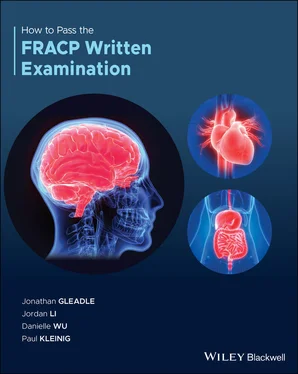9 9. A 32‐year‐old man presents to the emergency department with nausea, vomiting, and diffuse abdominal pain. He has had type I diabetes since age 7, which is treated with an intensive insulin regimen (insulin glargine 24 IU at bedtime and rapid‐acting insulin analogue before each meal). On examination, he is febrile and tachypnoeic. HR is 106 bpm and BP is 90/60 mmHg; he also has dry mucous membranes and poor skin turgor. He is slightly confused. The result of the strip for ketone bodies in urine is strongly positive and the concentration of β –Hydroxybutyric acid (β–OHB) in serum is elevated at 3.5 mmol/L [<0.5]. His ABG at room air demonstrates pH 7.11, PO2 95 mmHg, PCO2 28 mmHg. His other initial investigation results are shown below.TestsResultsNormal valuesSodium149 mmol/L135–145Potassium4.5 mmol/L3.5–5.2Bicarbonate11 mmol/L22–32Urea28 mmol/L2.7–8.0Creatinine143 μmol/L60–110Glucose26.3 mmol/L3.2–5.5Calcium2.85 mmol/L2.10–2.60Hb138 g/L135–175WBC17.1 x109/L4–11CRP57 mg/L0–8HbA1c9.6%–Which one of the following resuscitation treatment plans suggested by the emergency department team is the LEAST appropriate?Intravenous 0.9% sodium chloride 1000 ml/hour.Intravenous 8.4% sodium bicarbonate 100 ml over 1 hour.Intravenous potassium replacement with second bag of 0.9% sodium chloride.Intravenous short acting insulin and hold long‐acting insulin analogue.
10 10. A 58‐year‐old man is concerned regarding his inability to maintain an erection satisfactory for sexual intercourse over the past 6 months. He has had type 2 diabetes for 10 years, but his glycaemic control has been good with the most recent HbA1c at 7%. His other medical problems include hypertension, peripheral vascular disease, and hyperlipidaemia. His medication includes perindopril, gliclazide, metformin, amlodipine, and atorvastatin.Which of the following is INCORRECT regarding the management of erectile dysfunction?Measure morning total testosterone levels.Perform an exercise stress echocardiogram.Sildenafil treatment increases overall cardiovascular risk.Sildenafil treatment has a 65% chance of enabling satisfactory intercourse.
11 11. Which of the following chemotherapeutic agents carries the highest risk for inducing premature ovarian failure?Cyclophosphamide.Doxorubicin.Gemcitabine.Paclitaxel.
12 12. A 70‐year‐old man presents for follow‐up after recent initiation of citalopram for his depressed mood. He reports that his mood and sleep have improved, but his lethargy, low libido, and erectile dysfunction have not. He has a past history of type 2 diabetes. His BMI is 29 kg/m2. His HbA1c is 8.2%. His other current medications are empagliflozin and metformin. His fasting serum total testosterone level is between 6.4 and 6.7 nmol/L [8–30] on repeated measures, serum prolactin is 120 mIU/L [<325].Which of the following clinical benefits is he most likely to experience as a result of testosterone treatment?Better glycaemic control.Decreased fracture risk.Improved erectile function and libido.More energy.
13 13. A 35‐year‐old man with ESKD is on chronic haemodialysis. He has severe secondary hyperparathyroidism and has undergone a parathyroidectomy. Which one of the following biochemical abnormalities is the most likely to cause significant post‐operative complications and will require intensive monitoring post‐parathyroidectomy?Hypocalcaemia.Hypokalaemia.Hypomagnesaemia.Hypophosphataemia.
14 14. Which of the following metabolites is particularly important for macrophage and dendritic cell function?Citrate.Fumarate.Malate.Oxaloacetate.
15 15. A 29‐year‐old man has hypercalcaemia due to primary hyperparathyroidism which was treated with subtotal parathyroidectomy. During the perioperative period he complains of episodic headaches and palpitations. He is found to be hypertensive. Further investigations reveal that his 24‐hour urinary noradrenaline and adrenaline are 615 nmol/L [0–450] and 750 nmol/L [0–100] respectively. His serum calcitonin is also elevated at 135.5 ng/L [0–5.5].Which one of the following genes should be considered for mutational analyses?CDNK1B gene.MEN1 tumour suppressor gene.RET proto‐oncogene.Von Hippel‐Lindau (VHL) gene.
16 16. Which one of the following tests is LEAST useful in distinguishing between type 1 diabetes and maturity‐onset diabetes of the young (MODY)?C‐Peptide levels.Insulin autoantibodies (IAA).Islet cell cytoplasmic autoantibodies (ICA).Ketonuria.
17 17. Which of the following options best describe the pathogenesis of Paget's disease of bone?Increased osteoclast and osteoblast activity.Increased osteoclast and reduced osteoblast activity.Reduced osteoclast and increased osteoblast activity.Reduced osteoclast and osteoblast activity.
18 18. Regarding painful diabetic neuropathy, which of the following is correct?Approximately 80% of patients with diabetic neuropathy will suffer from pain.The prevalence of painful neuropathy in type 2 diabetes is more than twice that seen in type 1 diabetes.The intensity of pain is proportional to the degree of neuropathy.Tight glycaemic control in type 2 diabetes reduces the occurrence of painful neuropathy.
19 19. Which of the statements describing the pathogenesis of diabetic gastroparesis is INCORRECT?Enteric neuropathy increases transient lower oesophageal sphincter relaxation.Hyperglycaemia induces pyloric contraction, antral hypomotility and delays gastric emptying.Loss of interstitial cells of Cajal is the commonest enteric neuropathological abnormality in diabetic gastroparesis.Vagal neuropathy leads to reduced pyloric relaxation and impaired antral contraction.
20 20. A 35‐year‐old woman is diagnosed with phenotype A polycystic ovarian syndrome. Which one of following is NOT an associated consequence?Associated with 80% of cases of anovulatory infertility.Associated with increased risk of breast cancer.Associated with increased risk of endometrial cancer.Associated with increased risk of non‐alcoholic fatty liver disease.
21 21. A 63‐year‐old woman has resistant hypertension. She is currently taking four antihypertensive medications. She is referred to the general medicine outpatient clinic by her GP after the discovery of a mildly elevated plasma metanephrine level. The GP is concerned that she may have a phaeochromocytoma.What is the next most appropriate investigation?24‐hour urinary fractionated catecholamines and metanephrines.24‐hour urinary vanillylmandelic acid.Plasma catecholamines and metanephrines.MRI abdomen.
22 22. A 42‐year‐old woman with known type 1 diabetes presents to renal outpatient clinic for review of worsening renal function. Her type 1 diabetes is treated with glargine and short acting insulin Novorapid. She is waiting gynaecology appointment review for irregular vaginal bleeding, and also has chronic liver disease due to excessive alcohol consumption. You note her most recent HbA1c is 10.5% and her usual reading in the past is 8.5%. Her mean blood glucose measurement before meals in the past 3 months is 10.5mmol/L, which is consistent with an HbA1c of 8.3%.What is the most likely cause for the worsening of HbA1c in this patient?Chronic alcoholism.Chronic liver disease.Iron deficiency due to vaginal bleeding.Worsening of chronic kidney disease.
23 23. A 55‐year‐old woman presents with a 2‐month history of frontal headache. She reports having two car accidents recently which she attributed to not being able to see the right side of her car as she changed lanes. She had menopause at age of 50 and has no significant medical history and is taking no medications. The neurological examination reveals a right superior temporal visual field deficit. Her MRI head is shown below. Further investigation reveals normal TSH and T4 levels. Her IGF‐1, LH, FSH levels are also normal. Her early morning cortisol level is slightly low but the short Synacthen test demonstrates normal serum cortisol levels post‐Synacthen. The prolactin level is 54 ng/mL [<20].What is the most appropriate next step in her management plan?Consider transsphenoidal surgery.Start cabergoline.Start cortisol replacement.Watch and wait approach, repeat macroprolactin level.
Читать дальше












